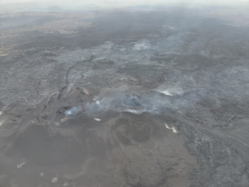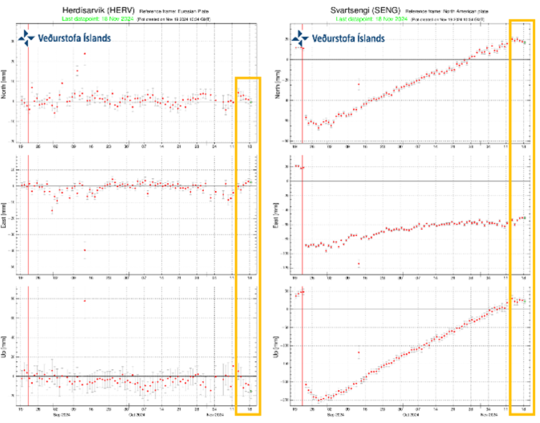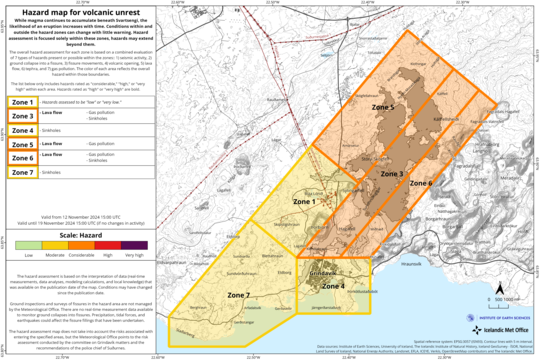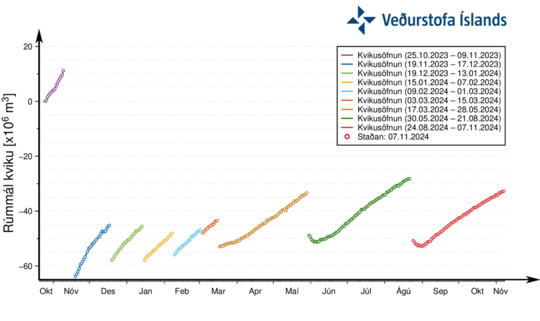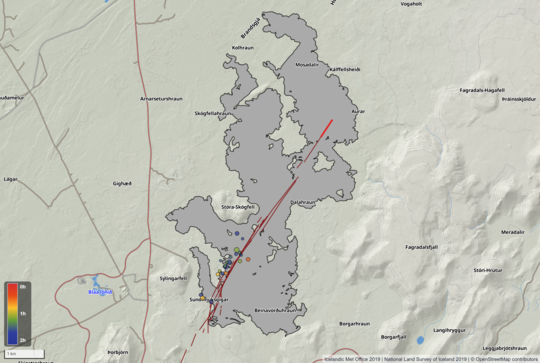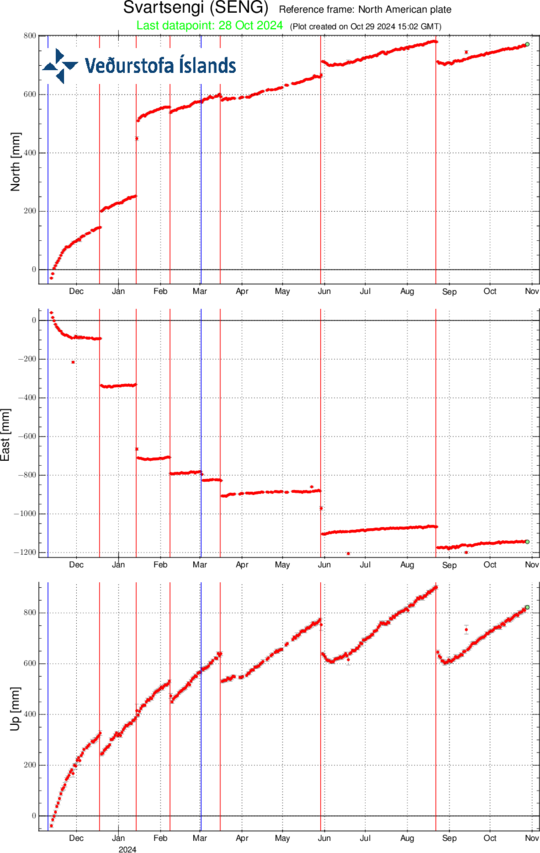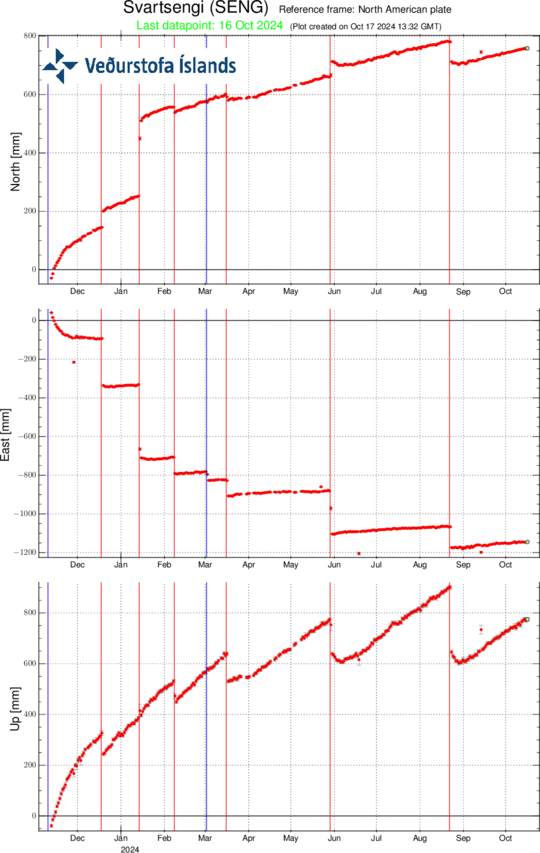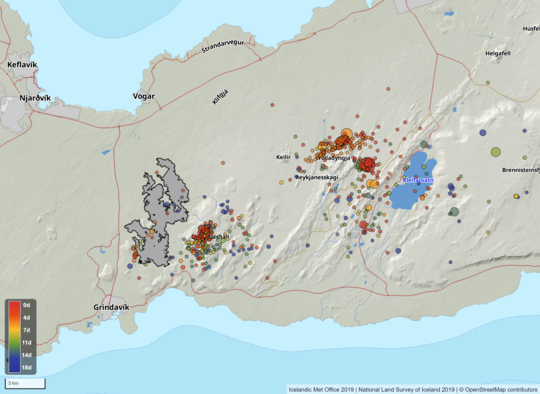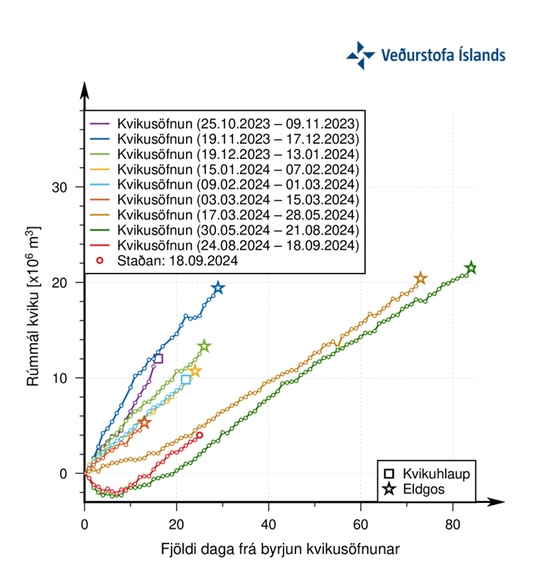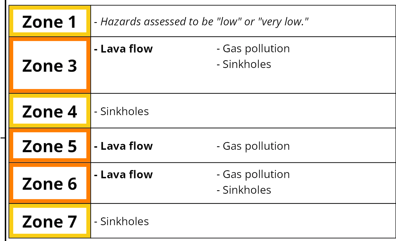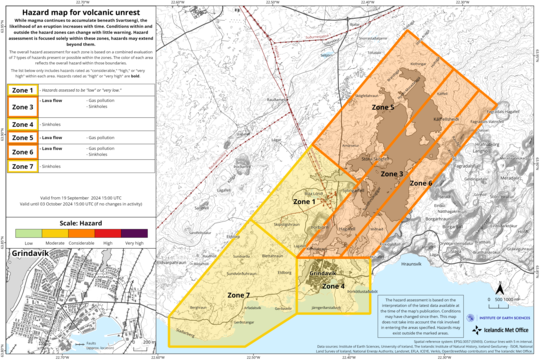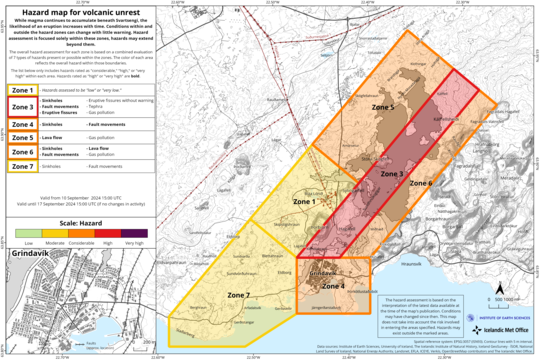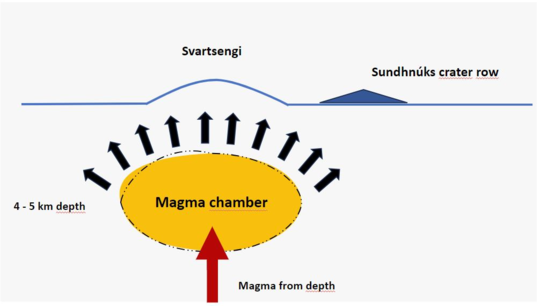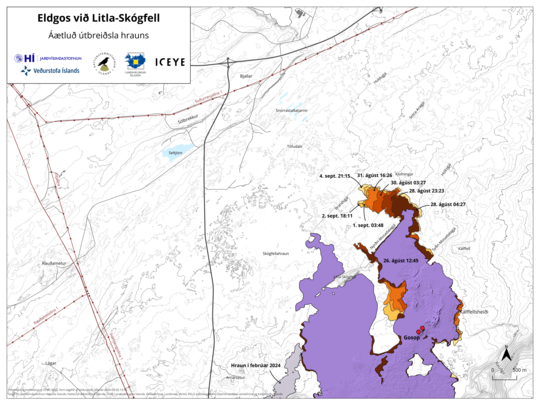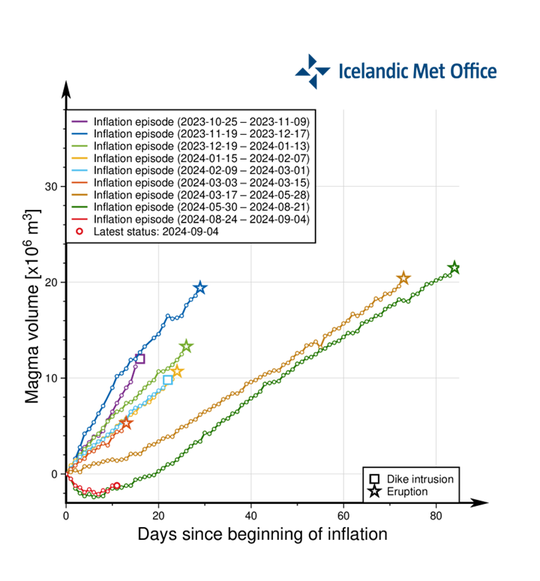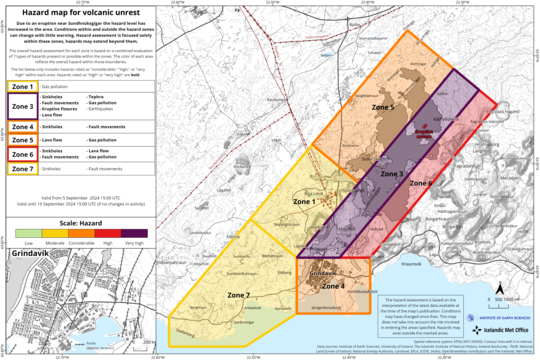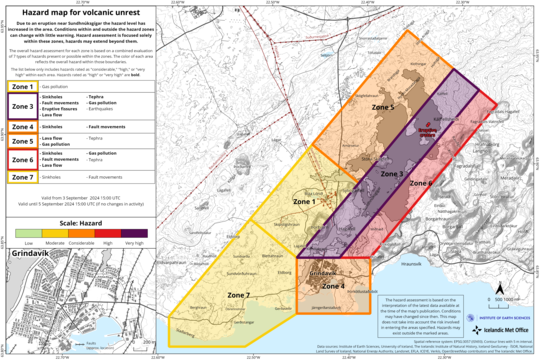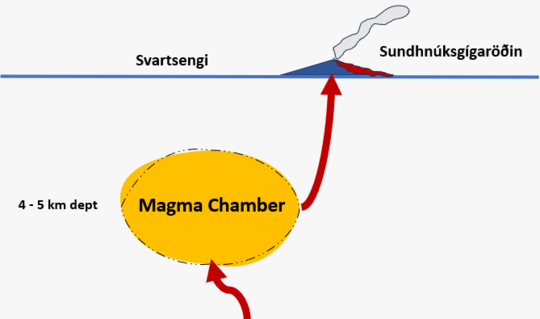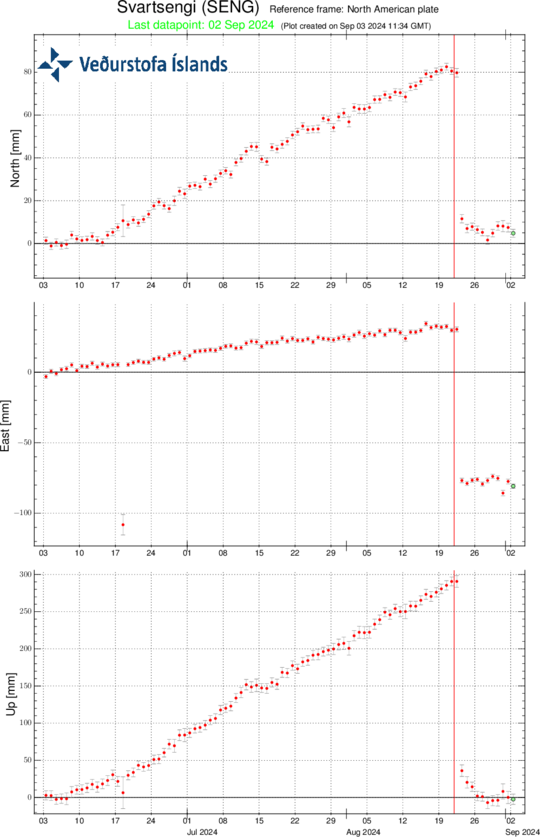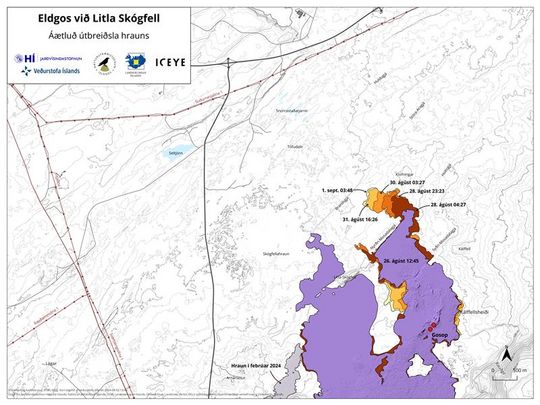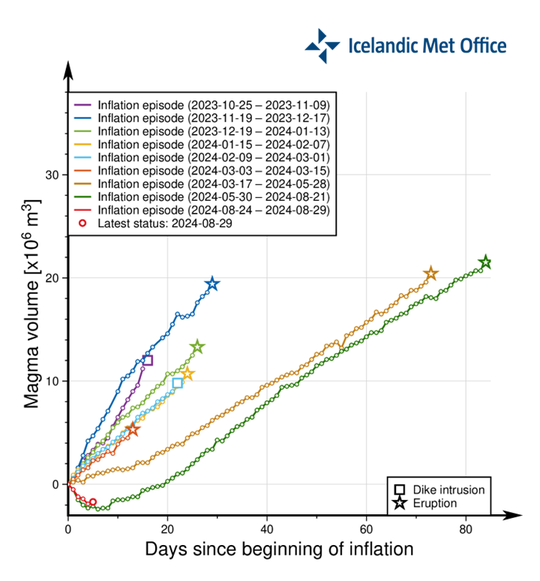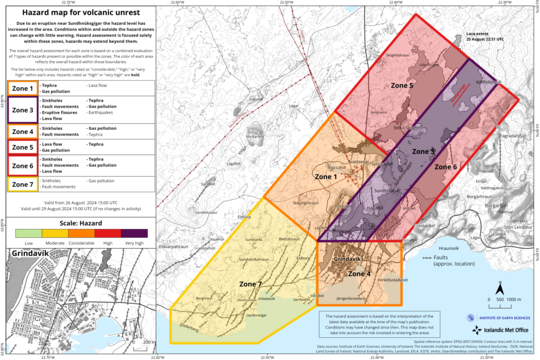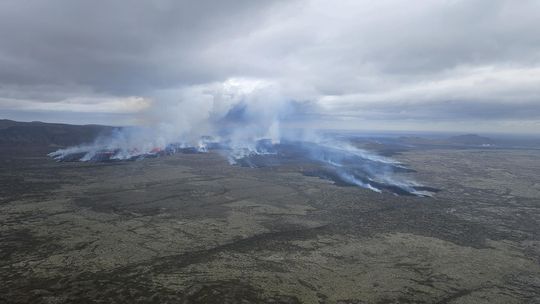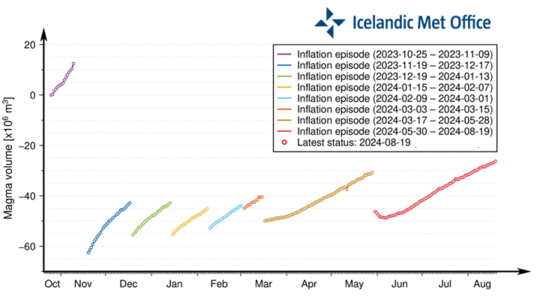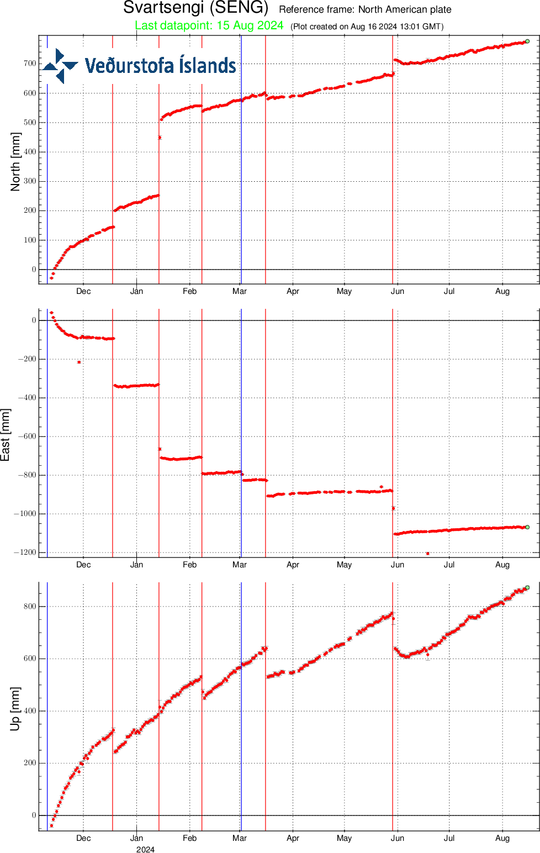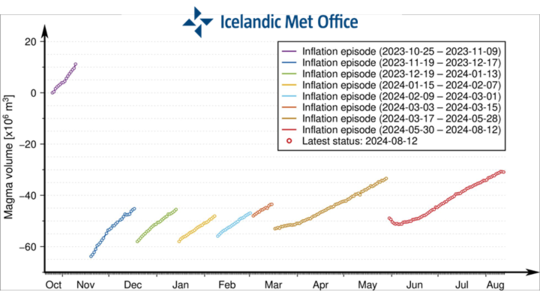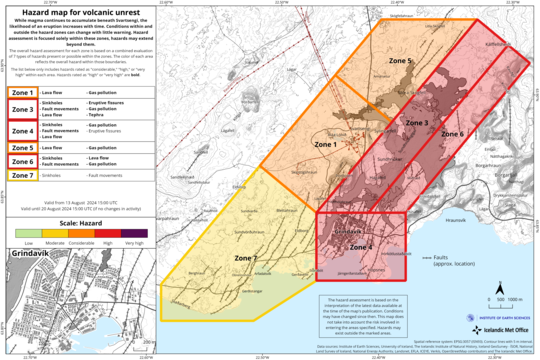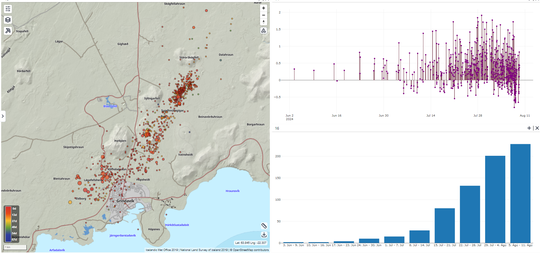Ground Uplift and Magma Accumulation Continue Beneath Svartsengi
Low Seismic Activity in the Area of Unrest
Updated 19. November at 14:45 UTCSeismic activity remains relatively low at the Sundhnúkar crater row.
Uplift and magma accumulation are ongoing beneath Svartsengi.
Interpretation of the most recent data indicates that an eruption in November is considered to be unlikely.
The hazard assessment remains unchanged.
Seismic activity in the Sundhnúkar crater row remains relatively low. A few earthquakes have been recorded daily, most of them located between Stóra-Skógfell and Sýlingarfell. On some days in the past week, bad weather has affected the sensitivity of the seismic monitoring system, potentially obstructing the detection of the smallest earthquakes.
Uplift and magma accumulation beneath Svartsengi continue. However, GPS measurements have shown indications that the rate of uplift may have slowed in recent days. It is too early to definitively conclude whether these changes indicate a slowdown in magma inflow, as similar variations have been observed across the GPS network far from Svartsengi. At this stage, external factors, such as space weather or changes in satellite orbits, cannot be ruled out as a possible cause.
If the GPS measurements reflect genuine changes in deformation and a slowdown in uplift and magma accumulation, this will become clearer next week when new satellite images are available to conduct a comparison with the deformation measured by the GPS network.
Graph comparing measurements from two GPS stations on the Reykjanes Peninsula, located in Svartsengi and Herdísarvík. During the period marked by the orange box, changes in deformation are visible in both Svartsengi and Herdísarvík, which is considered to be unusual. Many factors can cause small systematic shifts that are unrelated to ground deformation. Examples include issues with the reference system, satellite orbits, or solar activity (space weather).
Hazard Assessment Unchanged
The Icelandic Meteorological Office's scientists continue to assess that it is unlikely sufficient pressure will build up to trigger an eruption in November. One factor supporting this conclusion is the low seismic activity measured in the area. If the rate of uplift in Svartsengi changes or if there is a significant increase in seismic activity, this assessment will be revised accordingly.
The IMO has issued an updated hazard assessment, which remains unchanged from the previous one. This assessment is valid until November 26, barring any significant developments.
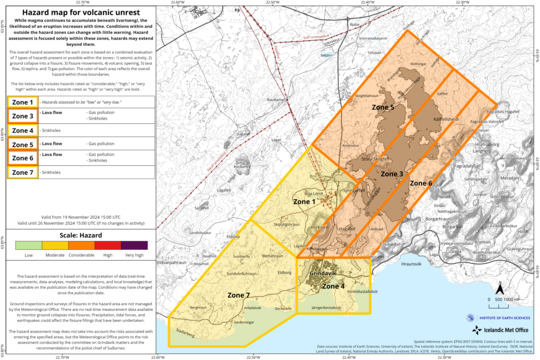
Updated 12. November at 17:45 UTC
Seismic activity along the Sundhnúkur crater row remains relatively low.
Land rise and magma accumulation beneath Svartsengi continue.
Based on the rate of magma inflow and the volume that has accumulated so far, the likelihood that an eruption will occur in November is considered to be low.
The hazard assessment remains unchanged.
Seismic activity along the Sundhnúkur crater row remains relatively low. Typically, a few earthquakes are recorded each day and are generally located between Stóra-Skógfell and Sýlingarfell. In recent days, however, weather conditions have decreased the sensitivity of the seismic monitoring system.
Ground uplift and magma accumulation under Svartsengi continue at a similar rate to recent weeks. An estimation of the volume of magma that will likely be required to trigger a new intrusion or eruption has been calculated. The minimum volume required is estimated to be approximately 23 million cubic meters. If magma accumulation continues at a similar rate, this threshold could be reached by the end of November.
According to the interpretation of the latest data, and based on experience from previous events, it is unlikely that sufficient pressure will have built up to trigger an eruption in November. If the rate of uplift in Svartsengi changes, this assessment will be adjusted accordingly.
Hazard Assessment Remains Unchanged
The Icelandic Meteorological Office has issued an updated hazard assessment, which remains unchanged from the previous one. The assessment is valid until November 19, unless circumstances change.
Using the Status of Magma Accumulation and Seismicity to Assess the Timing of the Next Event
Leading up to the last two eruptions, seismic activity in the area northwest of Grindavík increased in the weeks before the eruptions began. This seismic activity is interpreted to indicate that pressure in the magma chamber is starting to build, suggesting the next event may be approaching.
Lessons from previous magma intrusions and eruptions provide insight into estimating how much additional magma must accumulate under Svartsengi to trigger the next event. The period with an increased likelihood of a magma intrusion, and potentially an eruption, is defined by lower and upper uncertainty thresholds. It is also important to observe how seismic activity increases in conjunction with magma accumulation.
If a significant increase in seismic activity is recorded when the magma volume under Svartsengi reaches the lower uncertainty threshold, the likelihood of a new magma intrusion and potential eruption increases. The likelihood will then gradually increase as more magma accumulates and seismic activity intensifies. It should be noted that the risk of an eruption could be high for several weeks before a magma intrusion and possible eruption begins.
Updated 8. November at 18:00 UTC
Low levels of seismic activity have been recorded around the Sundhnúkur crater row following the earthquake swarm that occurred early on Monday, November 4
The total volume of magma under Svartsengi is now approximately 80% of what had accumulated before the last eruption, which began on August 22
Additional webcams have been installed to better monitor eruption fissures and lava flow
In the early hours of Monday, November 4, a brief earthquake swarm was recorded at the Sundhnúkur crater row. Since then, seismic activity in the area has been low, with only five small earthquakes detected since the swarm ended. It is likely that strong winds in recent days have affected the earthquake detection system's ability to detect the smallest earthquakes in the region.
Ground uplift and magma accumulation are ongoing in Svartsengi. The total magma volume beneath Svartsengi is now about 80% of what had accumulated prior to the eruption that started on August 22. If the rate of magma accumulation remains steady, it may soon reach the level observed before the last dike intrusion and eruption onset. However, the Icelandic Meteorological Office expects that a greater volume of magma will need to accumulate beneath Svartsengi to trigger the next intrusion.
Graph showing the development of magma accumulation and the estimated total volume of magma in the reservoir beneath Svartsengi since October 25. The total volume of magma under Svartsengi is now approximately 80% of what had accumulated before the eruption that began on August 22.
Additional Webcams Installed to Monitor the Area of Unrest
The Icelandic Meteorological Office has installed two new webcams. The new cameras are located at the northern and southern ends of the region experiencing unrest, on Litla-Skógfell in the north and Húsafjall in the south. In addition, plans are underway to install two more webcams in the near future. These webcams should improve monitoring capabilities of eruptive vents and lava flows in the event of an eruption. as the total length of the Sundhnúkur crater row—where eruptive fissures are likely to open—is around 9 km.
Updated 4. November at 18:30 UTC
- The earthquake swarm is in a similar location to where previous magmatic intrusions began
- This seismic activity may suggest a small amount of magma has migrated
- No earthquakes have been recorded since last night, and magma accumulation continues
Between 2 and 3 a.m. last night, a minor earthquake swarm occurred between Sýlingarfell and Stóra-Skógfell. Over twenty earthquakes were recorded, around or below a magnitude 1.0, at depths of 3 to 6 km. The location of these earthquakes is very close to areas where earthquakes were observed at the beginning of magma intrusions along the Sundhnúkar crater row in the past year. The earthquake swarm was brief, with no further activity detected since 4 a.m. last night.
Map showing the location of earthquakes between 2 and 4 a.m. last night. Dark red lines mark the eruptive fissures on the Sundhnúkar crater row from December 2023 to August 2024. The brighter red line represents the section of the eruptive fissure that remained active during the last eruption. The gray area indicates the extent of the lava flow produced by the eruption from August 22 to September 5. The placement of the fissure and lava field is based on data from the Icelandic Institute of Natural History's imaging team and the National Land Survey of Iceland.
No signs of deformation were observed by the GPS stations or fiber optics, nor were there pressure changes in the HS Orka boreholes in Svartsengi. When magma traveled from Svartsengi to the Sundhnúkar crater row in the past, these monitoring devices have shown clear signs.
One possible explanation for the seismic activity last night is that magma migration started but was halted before any significant intrusion occurred. No signs of changes in magma accumulation under Svartsengi have appeared on the IMO's instruments following the earthquake swarm.
Following standard response protocols, the Icelandic Meteorological Office notified the Civil Protection Department about the earthquake swarm and informed them that experts were assessing whether a magma intrusion had begun. Since no other indicators of an intrusion were detected, it was decided that no further action would be taken overnight.
Updated 29. October at 18:00 UTC
- Recent assessments of magma accumulation suggest that the likelihood of a new intrusion, possibly leading to an eruption, may rise by late November
- Seismic activity remains minimal around the Sundhnúkar crater row
- The hazard assessment remains unchanged
Uplift and magma accumulation have continued steadily in Svartsengi over the past few weeks. Seismic activity around the Sundhnúkar crater row remains very low, with only a few minor earthquakes recorded each day in recent weeks.
The Icelandic Meteorological Office has evaluated how much magma must accumulate beneath Svartsengi to likely trigger the next event. Using model calculations based on GPS and satellite data, this assessment has been updated. This new evaluation suggests that the likelihood of a new magma intrusion—and possibly an eruption—increases toward late November. This estimate relies on the available deformation data. If the rate of uplift in Svartsengi changes, this assessment will be adjusted accordingly.
GPS measurements at the station SENG near Svartsengi from November 11, 2023, to present, showing shifts in the north, east, and vertical directions (top, middle, bottom). The lowest line shows uplift in millimeters, with the reading from yesterday (October 28) indicated by a green dot. Red lines mark the start of the last six eruptions (December 18, 2023; January 14, February 8, March 16, May 29, and August 22, 2024). Blue lines indicate magma intrusions that did not result in eruptions (November 10, 2023, and March 2, 2024).
Monitoring Magma Accumulation and Increasing Seismic Activity to Evaluate the Timing of the Next Event
In the weeks leading up to the past two eruptions, seismic activity in the area northwest of Grindavík increased. This activity likely indicates that pressure is rising in the magma reservoir, suggesting that the next event may be approaching.
Insights from previous intrusions and eruptions in the region facilitate an estimation of how much magma must accumulate beneath Svartsengi to trigger the next event. The timeframe during which there is an increased likelihood of a magma intrusion and possibly an eruption is framed by lower and upper uncertainty bounds. However, it's also important to monitor how and when seismic activity intensifies in conjunction with magma accumulation.
If a significant increase in seismic activity is recorded when the volume of magma beneath Svartsengi reaches the projected critical thresholds, it's expected that the likelihood of a new intrusion and potential eruption will begin to increase. This probability will gradually rise as more magma accumulates and seismic activity intensifies. It may be necessary to anticipate a heightened likelihood for an eruption for several weeks before the next event will occur.
The Icelandic Meteorological Office's hazard assessment remains unchanged from last week. The current hazard assessment is valid through November 12, unless circumstances change.
Updated 22. October at 15:30 UTC
- GPS measurements and model calculations in the Svartsengi area show that ground uplift and magma accumulation continue.
- If the current rate of magma accumulation in the reservoir continues, the lower uncertainty threshold for the volume of magma that might culminate in a dike intrusion or eruption will be reached in early November.
- The current hazard assessment remains in effect until October 29, barring any changes.
Ground uplift and magma accumulation beneath Svartsengi are progressing at a rate consistent with recent weeks. Seismic activity has slightly increased in recent days, with around five earthquakes per day occurring along the dyke. The largest earthquake had a magnitude of 1.5.
Model calculations based on GPS data indicate that the volume of magma that has accumulated beneath Svartsengi is now approximately two-thirds of what it was before the previous eruption, which began on August 22.
If magma inflow continues at a similar rate, the lower uncertainty threshold that might feed a new intrusion or eruption is expected to be reached in early November. If a significant increase in seismic activity is detected around the same time, it could suggest that the likelihood of a new magma intrusion and a potential eruption is increasing. This likelihood will gradually rise as more magma accumulates and seismic activity intensifies.
A graph showing the progression of magma accumulation and the estimated total volume of magma in the reservoir beneath Svartsengi as of October 25 (red curve). The total volume of magma beneath Svartsengi is currently about two-thirds of what accumulated before the previous eruption began on August 22 (green curve).
Volume estimated through model calculations
The volume of magma that has accumulated beneath Svartsengi since the last eruption ended is estimated to be 14 million cubic meters, according to model calculations. It is estimated that around 24 million cubic meters of magma exited the magma chamber during the last eruption, which began on August 22 and was the largest eruption in this sequence of events. The uncertainty in these calculations is approximately +/- 5 million cubic meters. The volume of magma beneath Svartsengi is therefore projected to reach a value that is comparable to what it was before the last eruption when it enters within the range defined by the "lower uncertainty limit" (19 million cubic meters) and the "upper uncertainty limit" (29 million cubic meters).
The models, which are based on GPS data and are updated daily, indicate how much magma has accumulated since the last magma intrusion, providing an estimation of when the uncertainty thresholds may be reached. These models are based on the estimated inflow of magma into the reservoir beneath Svartsengi, and small changes in that flow can affect the final assessment. It is difficult to determine how far beyond these previously observed limits the magma volume can increase before an eruption starts. The trend has shown that the time between eruptions is increasing, as the volume of magma required to trigger the next magma intrusion or eruption appears to be increasing over time. It is possible that the risk of an eruption may be assessed to be high for some time before an event begins.
Updated 17. October at 16:00 UTC
Based on the current measurements, we estimate about 4-5 weeks until a new eruption will be considered likely
GPS measurements in Svartsengi area show that inflation continues at a similar rate
Warning immediately prior to an eruption can be short, even as short as only 30 minutes
Continue to be few earthquakes around the Sundhnúkar crater row
Hazard assessment unchanged
The progression of magma accumulation beneath
and land uplift above Svartsengi has remained unchanged in recent weeks. GPS
measurements in the Svartsengi area suggest that the land uplift continues at a
steady rate. It slowed down slightly about 1-2 weeks ago but has not diminished
further. While the rate of land uplift has diminished slightly, there is no
indication that magma accumulation beneath Svartsengi has stopped.
Experience of previous dyke movements and eruptions helps with estimating how much magma needs to accumulate beneath Svartsengi to trigger the next event. Models calculate that about 24 million m3 of magma left the magma accumulation zone beneath Svartsengi to erupt at the Sundhnúkur crater row in the last eruption that started August 22. There has been a trend that the same amount or more magma than left during the last event has needed to accumulate prior to each subsequent dyke movement or eruption.
If magma accumulation continues at a similar rate as now the most likely outcome is considered a dike propagation and possibly an eruption at the Sundhnúks crater row. At this point there still significant uncertainty in the possible timing of the next event. The magma accumulation will be monitored closely and efforts will be made to assess the time to the next event when more data will be available for analysis.
Warnings immediately prior to an eruption can be very short
When magma starts to move, the first signs are an increase in earthquakes, rapid changes in ground deformation and pressure changes in boreholes. The time between the first signal and when an eruption might start can be very short. There were only 30 minutes prior to the most recent eruption on August 22.
This assessment is based on the newest monitoring data from the Met Office and developments will continue to be closely monitored. There remains significant uncertainty about the timing of the next potential event and if the rate of magma accumulation changes this will affect the forecast.
Earthquakes around the Sundhnúkur crater row remain few but there continue to be several earthquakes per day for the past month. Earthquake activity west of Fagradalsfjall has diminished over the past few weeks.
The hazard assessment from the Met Office has been updated and remains unchanged. There remains the hazard of sinkholes in Area 4, Grindavík. The hazard assessment is valid until October 29 barring any developments.
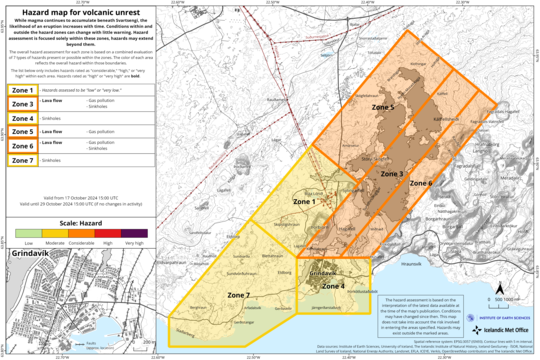
(Click on the map to make it larger)
Updated 24. September at 14:00 UTC
Land uplift continues at a similar rate
Total volume of the last eruption is just over 60 million m3
Minor seismic activity at the Sundhnúkur crater row for the last few weeks
Data from GPS instruments suggest that the land uplift in Svartsengi continues at a steady rate. Model calculations based on this data also suggest that magma accumulation beneath Svarstengi has continued at a similar rate for the last weeks. According to measurements of land uplift and estimates of the rate of magma accumulation, the development is similar to previous events in the area.
The photogrammetry team of the Icelandic Institute of Natural History (IIHN) and the National Land Survey of Iceland (NLSI) has processed data collected by specialists at Efla Consulting Engineers during a drone survey over the eruption site on 11 September. The data show that the lava flow field formed in the last eruption (22 August – 5 September) was 61.2 million m3 and 15.8 km2. This makes this last eruption the largest in the Sundhnúkur area since December 2023. The thickest part of the lava flow field is located around the crater that was active the longest.
Map showing the extent and thickness of the lava flow field formed during the last eruption. The map is based on data collected by specialists at Efla Consulting Engineers which was processed by the photogrammetry team of IIHN and NLSI. Grey colored areas show lava flow fields in the area since December 2023.
Seismic activity has been minimal for the last two weeks in the Sundhnúkur crater row. However, there has been some activity in the western part of Fagradalsfjall at a depth of about 6-8 km since the eruption ended on 5 September. There has also been considerable activity in Trölladyngja in the last few days. Most of the earthquakes in the area are small, but the largest one was of magnitude 3.0 on 22 September, just east of Trölladyngja. No deformation has been detected in the area around Trölladyngja.
Map showing seismic activity on the Reykjanes peninsula from 6th of 24th of September. The map also shows the contours of the lava flow field that formed in the last eruption. The contours of the lava are based on data collected by specialists at Efla Consulting Engineers which was processed by the photogrammetry team of IIHN and NLSI.
Updated 19. September at 17:00 UTC
Uplift at Svartsengi continues at a steady rate
Very little seismicity since the end of the last eruption
Updated hazard assessment. Valid until 3 October, barring any developments
Two weeks have passed since the end of the last eruption in the Sundhnúkur crater row. GPS data indicate that the uplift in Svartsengi continues at a steady rate. Model calculations based on this data estimate that magma accumulation beneath Svartsengi also continues at a similar rate. This trend is similar to what has been observed between the last magma propagations and volcanic eruptions on the Sundhnúkur crater row.
As long as magma
accumulation continues beneath Svartsengi and the amount of magma reaches
similar levels as prior to recent events, magma propagation and even a volcanic
eruption can be expected on the Sundhnúkur crater row. However, it is too early
to say when that might occur. Looking at the last two events, it is unlikely
that an event will take place in the coming weeks.
The graph shows the estimated amount of magma that has been added in the magma reservoir beneath Svartsengi between the eruptions or magma propagations that have occurred since November 2023. The green line shows the development of the magma accumulation between the last two eruptions. The red line shows the development of magma accumulation after the beginning of the last eruption (22 August), which shows a similar development as the green one.
Updated hazard assessment
The Icelandic Meteorological Office has updated the hazard assessment, which is valid until 3 October, barring any developments.
Considerable changes have been made, the main ones concern the assessment of the hazard due to fissure movements and sinkholes, but these two hazards have been lowered for almost all zones.
The lava field is still
very hot and the hazard from it is therefore considered high in the areas where
lava flowed during the last eruption and gas pollution from the lava field is
considerable. The hazard from tephra fall is now at the lowest level in all
zones.
In the new hazard assessment, the overall hazard for Zone 4 – Grindavík – is assessed as “moderate” (yellow level), but the hazard due to sinkholes is assessed higher, or “considerable”. The Icelandic Meteorological Office would like to point out that the Grindavík Committee is still working on fencing off and marking hazardous areas within the town. The hazard assessment does not take into account such mitigation measures that are considered necessary to prevent possible accidents or damage caused by the hazard that exists at any given time.
In addition to the hazard assessed by IMO, there are other factors that affect how much hazard is associated with staying in the town at any given time, such as limited escape routes, houses that can collapse, the hazard of damaged electrical cables, and due to construction work filling up fissures in the streets.
Updated 17. september at 16:00 UTC
The eruption site is dangerous to navigate
Updated hazard assessment
The hazard assessment from IMO has been updated and remains unchanged. The hazard assessment is valid until 19. September barring any developments.
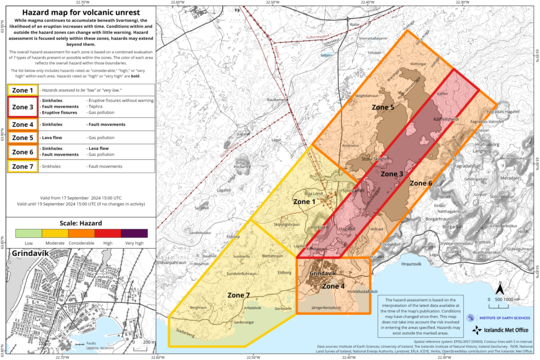
Updated 10. September at 17:00 UTC
Magma accumulation resumes beneath Svartsengi
Rate of uplift similar to previous events
The lava flow front is still active and thus unstable and there is a risk of collapsing from it
The eruption site is dangerous to navigate
Updated hazard assessment
Magma accumulation continues beneath Svartsengi. The rate of the uplift seems similar to that of previous events.
While magma accumulation continues beneath Svartsengi, magma propagation and even a volcanic eruption can be expected in the Sundhnúkur crater row. It is too soon to predict whether or when the next event might occur.
The lava flow front is still active even though the eruption is over. The lava can be expected to continue creeping forward over the next few days and there is a risk of collapse from it. The eruption site is therefore dangerous to navigate.
The hazard assessment from IMO has been updated and remains unchanged. The hazard assessment is valid until 17 September barring any developments.
Updated 6. September at 16:00 UTC
- No visible activity at the craters since yesterday evening
- Ground uplift has started again in the Svartsengi area
- The eruption lasted 14 days
- The hazard assessment is updated
The eruption which commenced on 22 August is now declared over, hence the hazard assessment has been updated. The main changes affect Zone 3, where the eruptive fissures opened at the beginning of the eruption. Zone 3 is now assessed to be at high hazard level (red) since the likelihood for vent openings, gas pollution and tephra fallout are assessed to be lower than before. Zone 6 is now assessed to be at considerable hazard as the likelihood of gas pollution is reduced. Within Zone 1 (Svartsengi) hazards are assessed to have either low or very-low likelihood.
Ground uplift has started again in the Svartsengi region indicating that magma has started accumulating within the magma body at 4-5 km depth. IMO will continue monitoring the ground deformation rate, but preliminary results from geodetic modelling indicate that the magma is accumulating at a rate which is like those estimated in periods which followed the end of previous eruptions.
The sketch shows the ”closed” system when the magma flows from depth (red arrow) into the Svartsengi reservoir to a shallower level at 4-5 km (orange domain) causing an increase in pressure and measurable ground deformation at the surface.Updated 5. September at 15:00 UTC
The intensity of the eruption continues to weaken
GPS measurements indicate that uplift at Svartsengi has resumed
Southwesterly winds are present at the eruption site, with a speed of 13-20 m/s. Air pollution from volcanic gas may be detected in Vatnsleysa and the capital area
The hazard assessment remains mostly unchanged
The activity of the eruption has continued to decrease in recent days. However, two eruptive vents still appear to be active. The lava field north of the eruption site continues to thicken and expand slowly to the north. At this point, the active lava flow does not threaten infrastructure near the eruption site. Furthermore, changes in volcanic tremor and gas emissions indicate that the eruption has diminished significantly in recent days.
A map showing
the actively expanding part of
the lava field that formed
during this eruption. The map is based on data from the Iceye satellite.
GPS measurements suggest that ground uplift has started again in Svartsengi. Meanwhile, the amount of lava extruded in the eruption at the Sundhnúkur crater row has decreased. This suggests that the influx of magma into the reservoir beneath Svartsengi is greater than the outflow from the surface eruption. This development is similar to what was observed after the last eruption began on May 29. In that instance, the uplift at Svartsengi became noticeable approximately two weeks after the eruption started.
Graph showing the estimated amount of magma that has accumulated beneath Svartsengi between the series of eruptions and intrusions that have been ongoing since November 2023. The green line shows the development of magma accumulation between the last two eruptions. The red line shows the development of magma accumulation after the current eruption began, following a very similar pattern to the green line.
The weather forecast for today (Thursday) shows southwesterly winds with a speed of 13-20 m/s at the eruption site, with some rain or drizzle in the morning and wind speeds decreasing to 10-15 m/s. Gas pollution from the eruption is expected to travel north and northeast and may be detected in Vatnsleysa and the capital area.
Seismic activity has slowed since the eruption began on August 22. In recent days, the activity has decreased further, with very little earthquake activity recorded. However, strong winds can affect the sensitivity of the seismic monitoring system, preventing small earthquakes from being detected.
The hazard assessment remains mostly unchanged, except that the risk from volcanic ash is now considered lower. The map is valid until September 10, barring any changes.
(Click on the map to make it larger)
Updated 3. September at 17:30 UTC
- Today's weather forecast indicates a northwesterly wind, which will carry air pollution to the southeast.
- The hazard assessment has been updated. The map has been expanded by 2 km to the northeast in zones 3, 5, and 6.
- The hazard level
in zone 5 has been downgraded from high to considerable.
The Icelandic Meteorological Office has updated its hazard assessment to reflect developments in the eruption, and this update remains valid until September 5, unless significant changes occur. The main update to the current assessment is that zone 5 has moved from high risk (red) to considerable risk (orange). This downgrade is due to a reduced risk of ashfall. The risk of gas pollution has been assessed considering the weather forecast for each zone over the coming days.
Another update to the hazard assessment map is that zones 3, 5, and 6 have been expanded by 2 km to the northeast. This change was made for two reasons. First, the new lava field created in this eruption has extended beyond the previous boundaries of these zones. Second, the magma dike formed on August 22 extended further northeast than zone 3 previously covered.
Updated 3. September at 14:00 UTCThe influx of magma into the reservoir beneath Svartsengi is likely equal to the outflow from the eruption.
Two active eruptive vents are located along the northern part of the fissure.
Seismic activity has decreased in recent days.
The hazard assessment will be updated later today.
In the past few days, no land uplift or subsidence has been detected at Svartsengi. This suggests that the inflow of magma into the reservoir beneath Svartsengi is comparable to the outflow of the eruption.
Several days of measurements will be necessary to confirm that land uplift has resumed. This is because day-to-day changes in geodetic measurements can occur due to various factors, including variations in atmospheric humidity or solar storms.
Schematic diagram illustrating conditions wherein there is an equilibrium between the influx of magma into the magma chamber and the outflow of lava from the eruption.
Ground movement at the GPS station SENG in Svartsengi since the end of June 2024 in the north, east, and vertical components (top, middle, bottom). The bottom graph shows vertical movement in millimeters. The red line marks the start of the latest eruption, which began on August 22.
Two eruptive vents are currently active in the eruption that began on August 22. The intensity of the eruption has significantly decreased in recent days. The lava field north of the vents continues to expand, but its rate growth has considerably slowed. For now, the lava flow does not threaten infrastructure near the eruption sites. The accompanying map, based on Iceye satellite data, shows the development of the lava field from August 26 to September 1.
A map showing the actively expanding part of the lava field that formed during this eruption. The map is based on data from the Iceye satellite.
Seismic activity around the Sundhnúkur crater row has significantly decreased in recent days. Most of the minor earthquakes that are being recorded are located on the northern part of the fissure that was active at the beginning of this eruption.
An updated hazard assessment will be published later today.
Updated 29 August at 18:00 UTC
In the last few days, the activity in the eruption has remained fairly stable
Lava flows mostly to the northwest but also to the east
Greater seismic activity post-eruption than in previous eruptions. About 20 earthquakes in the last 24 hours
The gas distributionforecast today is northwesterly winds, directing gas pollution to the southeast
The eruption continues in the area northeast of Stóra-Skógfell. The activity has remained fairly stable for the last few days. There are two main lava fountains active which seem quite vigorous. Lava continues to flow mostly to the northwest at a slow rate but also to the east.
Here we see the development of the lava flow based on ICEye satellite images during the period from August 26th at 22:17 to August 28th at 23:23.
Greater seismic activity is being detected since the onset of the eruption on 22 August than in previous eruptions in the area. That is probably because the eruption is now taking place further north, where more tension is still within the bedrock, whereas tension has been released significantly further south in previous events. About 20 earthquakes were detected in the dyke area for the past 24 hours and 110 earthquakes since Monday, 26 August. They are mostly confined to the volcanically active area.
Land subsidence is still being detected at Svartsengi, but at a slower rate. This development is similar to the last eruption. The magma reservoir is believed to be emptying at a higher rate than filling up.
The graph shows the estimated amount of magma that has accumulated beneath Svartsengi between the volcanic eruptions or magma intrusions that have occured since November 2023.
The gas distributionforecast for today , Thursday 29 August, is northwest 3-8 m/s and gas pollution will move to the southeast. Changing to westerly and southwesterly winds tonight, causing gas to be directed eastwards and northeast over the southwestern part of the country. Tomorrow (Friday), southwesterly winds of 10-15 m/s, causing pollution to be directed north over Vogar on Vatnsleysuströnd. Air quality can be monitored on the Environment Agency's air quality detectors on their website.
Hazard assessment
The hazard assessment has been updated. The main changes affect Zone 1, which goes from considerable (orange) to moderate (yellow) hazard level. The change is done considering a lower hazard because of lava flow invasion, gas pollution and tephra fallout. A reduced level of gas pollution, originating from the active vent, is assessed also for Zone 4 (Grindavík) and 7 according to gas forecast dispersion in the coming days. The area within the dashed line in Zone 5 represents a probable outline of the development of the lava flow front in a few days.
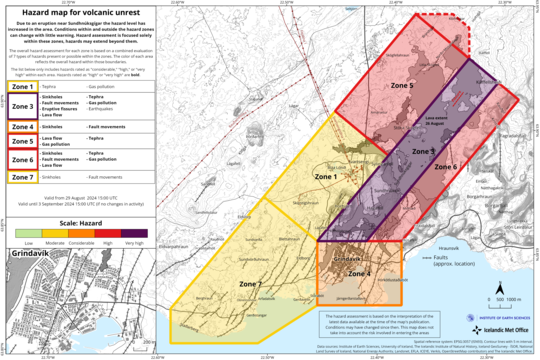
(Click on the map to make it larger)
Updated 26 August at 17:30 UTC
- The eruption continues in the area northeast of Stóra Skógfell.
- Estimated extrusion rate at the beginning of the eruption is about 1.500-2.000 m3/s but is now significantly less, several tens of cubic meters per second.
- Land subsided about 40 cm when magma propagated from the Svartsengi reservoir into the Sundhnúkur crater row on the evening of August 22nd.
- All data indicate that this eruption is the largest since the autumn of 2023.
- The area of the lava field has reached 15.1 km2.
- According to the gas distribution forecast, there will be pollution from the eruption and wildfires in Svartsengi, Reykjanesbær and Vogar, among other places.
- Updated hazard assessment.

Time series from the GPS station HS02 at
Svartsengi since the end of June 2024, in north, east and vertical directions
(top, middle, bottom images, respectively). The bottom time series shows land
uplift in millimeters. The red lines are the dates of the beginnings of the
last eruptions, which started on 28 May and 22 August.
Seismic activity has remained low in the area and has been mainly detected in the northernmost fissure for the last 24 hours. One earthquake of M3.4 occurred close to Kleifarvatn just before midnight last night.
Updated hazard assessment
(Click on the map to make it larger)Updated 23 August at 16:00 UTC
The intensity of the eruption has decreased significantly since yesterday
The main activity is now limited to two areas
The most active fissure is the one which opened during the night
No activity south of Stóra-Skógafell
The seismic activity and ground deformation rate at the eruption site has slowed down. Today (23 August) the eruptive activity has been primarily occurring north of Stóra-Skógafell.
According to information from the Icelandic Coast Guard's surveillance flights, that flew at midday today, the main activity is limited to two areas north of Stóra-Skógafell.

A photo from a surveillance flight taken by the Icelandic Coast Guard just after noon today, looking over the northernmost part of the eruption fissure. (Photo: Almannavarnir/Björn Oddsson)
The fissure that opened at the beginning of the eruption is now characterized by very low activity. Only a small fissure appears to be erupting on a small section directly east of Stóra-Skógafell. Activity seems to be reducing to a few demarcated areas, as happened in previous eruptions. The lava tongue that approached the Grindavíkurvegur road at the beginning of the eruption has therefore almost stopped.
A photograph from the Icelandic Coast Guard's surveillance flight this morning. Looking south. Þorbjörn and Svartsengi can be seen in the distance on the right side of the picture. (Photo: Almannavarnir/Björn Oddsson)
Most of the flow of lava has been progressing to the northwest, as can be seen in the above photograph and the map that was published before noon in the previous news.
The propagating lava flow is causing extended wildfires in the area. The pollution caused by this eruption is transported fast to the south. Satellite images from today (Sentinel 5p) show the SO2 cloud travelling farer than 1,000 kilometers toward Scotland. See for more information on gas pollution forecast in the coming days.
Updated hazard assessment
The Icelandic Met Office has updated the hazard assessment in the light of the latest data and observations. The main changes are due to the low level of seismicity and deformation in the area detected south of Stóra-Skógafell. As no lava flows are propagating to the south, the hazard associated with lava flow invasion has been also reduced in the areas south of Sunhnúks.
The main change from the last hazard assessment is the hazard level for area 4 - Grindavík - which has been lowered from red to orange.
The hazard assessment is valid until 15:00 UTC, Monday 26 August, if the level of activity will be unchanged.
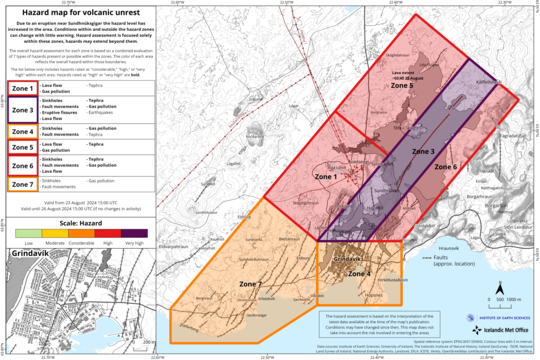
(Click on the map to see it larger)
Updated 23 August at 12:00 UTC
The eruptive fissure is located further north than in previous eruptions.
Seismic activity and deformation significantly decreased after 4 AM this morning.
Gas pollution from the eruption will spread south and southeast today and tomorrow.
The hazard assessment will be updated later today.
At the onset of the eruption, the fissure opened between Stóra-Skógfell and Sundhnúkur, similarly to previous eruptions. During the first few hours, the fissure steadily extended northeast from Stóra-Skógfell until between 5 and 6 AM this morning. As the eruptive activity migrated northeast, there was a reduction in activity along the southern end of the fissure, with the eruption now taking place along a fissure that runs 2-3 km northeast from Stóra-Skógfell. The currently active fissure is located slightly farther north than the other eruptions that have occurred in this area since December 2023.
As the activity on the eruptive fissure shifted northward, the lava flow advancing towards Grindavíkurvegur, north of Svartsengi, slowed. The primary lava flow is now moving to the northwest, north of Stóra-Skógfell.
Map showing the extent of the lava flow (hatched area) formed during this eruption and the location of the eruptive fissure (red line) as it was at 03:39 last night. Also shown are the lava fields that have formed in the area since December 2023 (purple layers). The map is based on data from the IcEYE satellite.
As the eruptive fissure extended, significant seismic activity and deformation were recorded around the fissure. After 4 AM, seismic activity significantly decreased, and the rate of deformation decreased, which corresponds with the development of the fissure. Despite this deceleration, deformation is still ongoing in the area.
On the left is a map showing an overview of the development and location of earthquakes around the Sundhnúkar Crater Row from 8:00 PM last night to 11:00 AM today. On the right is a bar graph exhibiting the number of earthquakes recorded each hour.
There will be northerly and northwesterly winds at the eruption site until tomorrow evening. Therefore, gas pollution from the eruption will spread south and southeast. You can monitor the gas dispersion forecast on our website.
Updated 23. August at 10:00 UTC
The vigor of the eruption has decreased somewhat since its peak yesterday.
The activity is now mostly confined to two fissures, the northern end of the fissure that erupted first and the fissure that opened north of the first one.
Seismicity decreased rapidly after 4 A.M. However, ground extension continues north of Stóra-Skógfell, which suggests that the eruption has not reached equilibrium.
Updated 23 August at 01:00 UTC
The length of the eruptive fissure appears to remain the same for the last hour (approx. 3.9 km).
The seismicity is fairly stable, and the main activity is at the northern end of the eruptive fissure. It is therefore unlikely that the fissure will extend to the south. It cannot be ruled out that the eruptive fissure could extend to the north.
The lava flow continues both to the east and west towards Grindavíkurvegur. No lava flow is observed to the south towards Grindavík.
The Coast Guard will carry out another surveillance flight later tonight.
The next update will be provided tomorrow morning. IMO maintains a 24-hour monitoring of all natural hazards and will publish posts on Facebook later in the night with the latest information about the volcanic activity.
IMO has updated the hazard assessment which is valid until 3 P.M. today, Friday, August 23rd .
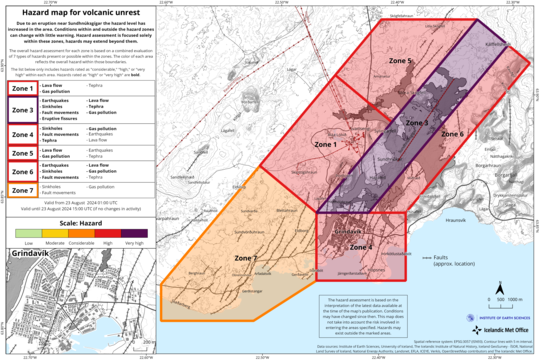
Updated 22 August at 11:25 UTC
IMO provides a gas distribution forecast. North and northwesterly winds are forecast tomorrow in the eruption area tomorrow. Gas pollution will spread to the south and southeast.
Updated
22 August at 10:54 UTC
The eruptive fissure now extends as far north as the eruptive fissure from the December 2023 eruption.
Updated 22 August
at 10:45 UTC
Seismic activity continues at the northern end of the fissure. At 10:37 P.M. an earthquake of M4 was detected. It originated about 3 km northeast of Stóra-Skógsfell. Lava flows to the east and west. There is no lava flow towards Grindavík.
Updated 22 August at 10:30 UTC
The eruptive fissure has extended to the north. The total length of the fissure is now about 3.9 km, so it has lengthened by 1.5 km in approximately 40 minutes.
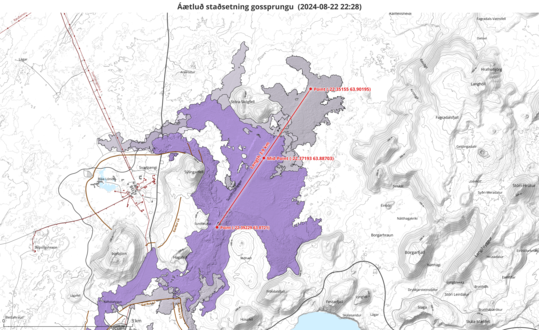
Updated 23 August at 01:10 UTC
The length of the eruptive fissure appears to remain the same for the last hour (approx. 3.9 km).
The seismicity is fairly stable and the main activity is at the northern end of the eruptive fissure. It is therefore unlikely that the fissure will extend to the south. It cannot be ruled out that the eruptive fissure could extend to the north.
The lava flow continues both to the east and west towards Grindavíkurvegur. No lava flow is observed to the south towards Grindavík.
The Coast Guard will carry out another surveillance flight later tonight.
The next update will be provided tomorrow morning. IMO maintains a 24-hour monitoring of all natural hazards and will publish posts on Facebook later in the night with the latest information about the volcanic activity.
IMO has updated the hazard assessment which is valid until 3 P.M. today, Friday, August 23rd .
Updated 22 August at 21:50 UTC
The eruptive fissure initially expanded both to the north and to the south. The length of the fissure has not been estimated at this point. Currently, no seismic activity is detected south of the eruptive fissure. The seismic activity is mainly to the north, which indicates that the magma is breaking its way to the north rather than to the south.
Updated 22 August at 21:26 UTC
A volcanic eruption has begun. A fissure has opened east of Sýlingarfell and by 9:30 a gas plume which reached approximately 1 km height dispersed to the south.
Updated 22 August at 21:25 UTC
At 20:48 UTC an intense earthquake swarm started in the Sundhnúkur crater row between Stóra-Skógfell and Sýlingarfell.
Increased pressure has also been measured in boreholes. These are clear signs that a dyke propagation has started and it is likely that an eruption is imminent.
Updated 20 August at 15:00 UTC
A trend of increasing seismic activity has been observed in recent days.
Two earthquakes exceeding magnitude 2 were recorded last night.
Clear signs of increasing pressure are observed in the area.
Magma accumulation and land uplift continue at a steady rate compared to recent days.
The volume of magma beneath Svartsengi is greater than it was before prior eruptions in the region.
The hazard assessment and scenarios remain unchanged.
Seismic activity around the Sundhnúkar Crater Row continues to exhibit behavior similar to that observed in the days leading up to the most recent eruption, which began on May 29. Two earthquakes with magnitudes above 2 were recorded last night, bringing the total to six such earthquakes in the past week.
The seismic activity indicates that pressure continues to build in the area due to magma accumulation under Svartsengi.
The progression of magma accumulation and land uplift has remained unchanged in recent days. Model calculations show that the total volume of magma beneath Svartsengi is now greater than it was before the previous events.
The likelihood of a new magma intrusion and perhaps an eruption in the Sundhnúkar Crater Row remains high.
The hazard assessment and potential scenarios remain
unchanged.
Graph showing the development of magma accumulation and the estimated total amount of magma in the magma chamber beneath Svartsengi since October 25, 2023.
Updated 16 August at 14:50 UTC
- Uplift and magma accumulation at a steady rate for the last few days
- Volume of magma under Svartsengi estimated to be greater than before the last eruption on May 29
- Seismicity steady with about 60-90 earthquakes recorded per day
- Hazard assessment can be seen here, valid until August 20 unless conditions change
Seismicity has been fairly steady in recent days, with about 60 to 90 earthquakes recorded per day. Most of the earthquakes are small, under a magnitude 1.0, in the area from Mt. Stóra-Skógfell to Grindavík. This is similar to the activity observed in the past two weeks.
Uplift and magma accumulation have been occurring at a fairly steady rate in recent days. Model calculations also show that the volume of magma under Svartsengi is now estimated to be greater than it was before the last eruption, which began on May 29. Before the last eruption, magma accumulation continued for two weeks after reaching previous thresholds before an eruption began.
When comparing the activity before previous eruptions and magma intrusions, the current seismic activity along with the uplift shows clear signs that a magma intrusion and even an eruption could begin at any time. Based on the last eruption, continued magma accumulation could potentially be required for an additional 2-3 weeks before a new eruption starts.
The Icelandic
Meteorological Office continues to monitor the situation closely around the
clock. The hazard assessment can be seen here and is valid until August 20
unless conditions change.
Updated 13 August at 14:00 UTC
Deformation and seismic activity are similar as prior to the last eruption on the Sundhnúkur crater row
The volume of magma beneath Svartsengi is estimated to be just over 20 million cubic metres
Seismic activity in the area has increased in the last few weeks. About 60-80 earthquakes per day are detected
Hazard assessment is unchanged from last week and is valid until 20 August, barring any developments
Deformation signals and seismic activity show similar patterns as prior to the last eruption on the Sundhnúkur crater row. Model calculations also suggest that the volume of magma beneath Svartsengi is now estimated to be greater than it was prior to the last eruption, which started on 29 May. Prior to the onset, land uplift and magma accumulation continued for two weeks until an eruption started. It can thus be assumed that magma propagation and a volcanic eruption can start at any time, but based on previous occurrences it may be delayed.
Seismic activity in the area has increased in recent weeks and development is similar as before the previous magma propagations and volcanic eruptions. The last seven days have been similar, with about 60-80 earthquakes detected per day in the area between Stóra-Skógfell to Grindavík. Most of the earthquakes are at depths between 2-4 km, the shallowest in the area between Stóra-Skógfell and Sýlingarfell.

Seismic activity on the Sundhnúkur crater row since 1 December 2023 showing the patterns in seismic activity between eruptions and magma propagations.
Deformation
data suggest that land uplift is ongoing but at slower rate. That indicates
that magma pressure is increasing beneath Svartsengi. Model calculations
estimate that over 20 million cubic metres of magma have been added to the
magma reservoir beneath Svartsengi since the last eruption. This is similar to
the observed trend which lead to the last magma propagations and volcanic
eruptions, as shown in the following graph.
Graph showing the development of magma accumulation and estimated total volume of magma in the magma reservoir beneath Svartsengi from 25 October. Each magma propagation has not exhausted the magma reservoir, and therefore the starting status of magma accumulation beneath Svartsengi will vary in each cycle after November 2023.
Hazard assessment unchanged
The hazard assessment issued by the Icelandic Meteorological Office remains unchanged and is valid until 20 August, barring any developments. The possible scenarios are also unchanged.
Scenario 1 - Eruption between Stóra-Skógfell and Sundhnúkur (central part of zone 3 on the hazard assessment map). Similar location to eruptions that began on 18 December 2023, 8 February, 16 March, and 29 May 2024.
- The likely precursor is a localized earthquake swarm between Stóra-Skógfell and Sýlingarfell, acceleration in deformation, and pressure changes in boreholes in the area.
- Very short pre-eruption warning time (less than 30 minutes).
- Lava could reach Grindavíkurvegur near Þorbjörn within 1.5 hours and Grindavíkurvegur near Svartsengi within 3 hours.
Scenario 2 - Eruption south of Sundhnúkur, near Hagafell, and extending south towards and potentially within northern Grindavík (southern part of zone 3 on the hazard assessment map and the northern part of zone 4). Similar location to the eruption that began on 14 January 2024.
- The likely precursor is an earthquake swarm starting near Stóra-Skógfell or Sýlingarfell and moving south, acceleration in deformation, and pressure changes in boreholes in the area.
- The warning interval for an eruption in this area would probably be longer than in scenario 1, but it is uncertain by how much. The length of the warning period depends on how far south the magma must break a pathway to the surface.
- Lava could reach Nesvegur and Suðurstrandarvegur within 1.5 hours. Lava flows could potentially close escape routes on land within about 6 hours.
- In this scenario, lava could reach the sea east of Grindavík within 1.5 to 3 hours. If lava reaches the sea, it could cause localized hazards due to rapid cooling of the lava. Initially, there would be a hazard due to ash and gas formation, primarily hydrochloric acid (HCl). Within a radius of about 500 meters from where the lava enters the sea, conditions would be life-threatening.
- A magma intrusion that reaches south of Hagafell will likely cause significant fault movements in Grindavík.
- There is a possibility that lava could erupt within Grindavík. One scenario is that lava erupting from a vent north of the protective barriers at Grindavík could flow into existing fissures and then re-emerge again within the town limits. Another scenario is the possibility of an eruptive fissure opening within Grindavík. However, in such a situation, it is likely that a fissure would first open north of the town before opening within the town limits.
Updated 9 August at 12:30 UTC
- The number of earthquakes in the Sundhnúkur crater row continues to increase. Almost 300 earthquakes have been recorded since Monday, August 5
- Around 300 earthquakes recorded since August 5. All of them are small earthquakes
- Uplift and magma accumulation under Svartsengi remain like the last few days
- Hazard
assessment remains unchanged. See here.
The number of recorded earthquakes in the Sundhnúkur crater row continues to increase. All of these are small earthquakes, with magnitudes below M2.0, and most of them below M1.0. This week, since Monday, August 5, nearly 300 earthquakes have been recorded in the area. The number of earthquakes has been increasing in recent weeks.
Deformation data and model calculations show that uplift and magma accumulation under Svartsengi remain similar to the last few days. These data indicate that magma pressure continues to increase, and this is a similar trend to the weeks leading up to previous magma intrusions and eruptions.
Overview of earthquake activity around the Sundhnúkur crater row based on reviewed earthquakes from June 3 to August 9. On the left, the location of the earthquakes is shown on a map; in the upper right, there is a graph showing the magnitude of the earthquakes; and in the lower right, there is a bar chart showing the number of earthquakes per week. The bar chart shows increasing seismic activity in recent weeks compared to the low activity during the last eruption from May 29 to June 22.
The IMO's hazard assessment remains unchanged from before. The updated hazard assessment is valid until August 13, if no changes occur. The scenarios presented in the last news update also remain unchanged.
Updated 6 August at 15:30 UTC
The number of earthquakes per day on the Sundhnúkur crater row is slowly increasing
According to model calculations, enough pressure has built up in the system to trigger a new event
Hazard assessment remains unchanged from last week
The number of earthquakes per day detected on the Sundhnúkur crater row and the surrounding area continues to increase. About 60 earthquakes were detected in the last 24 hours. In comparison, the number of earthquakes just over a week ago was about 30 earthquakes on average per day.
The development of land uplift and magma accumulation beneath Svartsengi has remained similar for the past few days as the land uplift continues to decrease at a slow rate. That, together with increased earthquake activity indicates that pressure in the system is increasing. It remains to be seen how much pressure the crust can withstand before it brakes, and another magma propagation occurs.
According to model calculations, the estimated amount of magma in the magma reservoir beneath Svartsengi is comparable to what it was prior to the onset of the eruption that started at the end of May. Initial model calculations suggested that by the end of this week, the upper limit of amount needed to trigger a new magma propagation and even a volcanic eruption would be reached. The rate of uplift has decreased, which can result in a longer time window if a new event doesn't start in the next few days.
The updated hazard assessment issued by the Icelandic Meteorological Office remains unchanged and is valid until 13 August, barring any developments. The possible scenarios are also unchanged.
Scenario 1 - Eruption between Stóra-Skógfell and Sundhnúkur (central part of zone 3 on the hazard assessment map). Similar location to eruptions that began on 18 December 2023, 8 February, 16 March, and 29 May 2024.
- The likely precursor is a localized earthquake swarm between Stóra-Skógfell and Sýlingarfell, acceleration in deformation, and pressure changes in boreholes in the area.
- Very short pre-eruption warning time (less than 30 minutes).
- Lava could reach Grindavíkurvegur near Þorbjörn within 1.5 hours and Grindavíkurvegur near Svartsengi within 3 hours.
Scenario 2 - Eruption south of Sundhnúkur, near Hagafell, and extending south towards and potentially within northern Grindavík (southern part of zone 3 on the hazard assessment map and the northern part of zone 4). Similar location to the eruption that began on 14 January 2024.
- The likely precursor is an earthquake swarm starting near Stóra-Skógfell or Sýlingarfell and moving south, acceleration in deformation, and pressure changes in boreholes in the area.
- The warning interval for an eruption in this area would probably be longer than in scenario 1, but it is uncertain by how much. The length of the warning period depends on how far south the magma must break a pathway to the surface.
- Lava could reach Nesvegur and Suðurstrandarvegur within 1.5 hours. Lava flows could potentially close escape routes on land within about 6 hours.
- In this scenario, lava could reach the sea east of Grindavík within 1.5 to 3 hours. If lava reaches the sea, it could cause localized hazards due to rapid cooling of the lava. Initially, there would be a hazard due to ash and gas formation, primarily hydrochloric acid (HCl). Within a radius of about 500 meters from where the lava enters the sea, conditions would be life-threatening.
- A magma intrusion that reaches south of Hagafell will likely cause significant fault movements in Grindavík.
There is a possibility that lava could erupt within Grindavík. One scenario is that lava erupting from a vent north of the protective barriers at Grindavík could flow into existing fissures and then re-emerge again within the town limits. Another scenario is the possibility of an eruptive fissure opening within Grindavík. However, in such a situation, it is likely that a fissure would first open north of the town before opening within the town limits.
